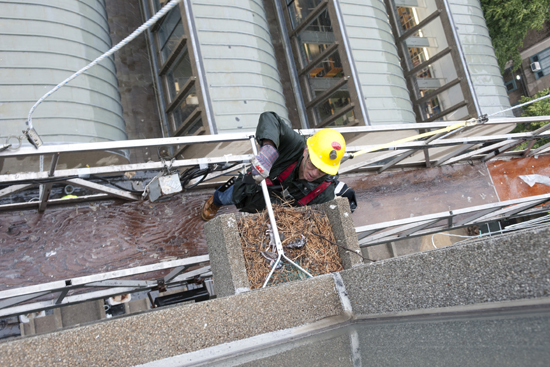Have you heard about the free digs on campus? The one with sweeping views of the Boston skyline, all-you-can-eat dining, and considerate neighbors?
Too bad—the rooftop has already been claimed by a red-tailed hawk.
The young bird of prey—nicknamed “Redstone” by a BU staffer—had been living in a nest on the side of the eighth floor of the 265-foot School of Law main tower. While the bird is a welcome addition to the BU campus, officials worried that he and his mother would be perturbed by the construction of LAW’s new west wing and renovations to the tower.
“It’s a great thing to see hawks drifting up above,” says William Walter, assistant vice president for operations and services at Facilities Management & Planning. “But there’s a balance in nature, and you need to learn to share the space. We figured that the birds would be happier if they were moved somewhere with less noise and disruption.”
Moving the nest also decreases the likelihood of the mother hawk’s attacking a construction worker who might unknowingly get too close to its chick, as happened in 2008 when a red-tailed hawk charged a teenage girl touring Fenway Park.
Walter points to another benefit of having birds of prey on campus: pest control. The flying predators hunt unwanted, disease-carrying guests like rats and mice.
Over the years, BU has been visited by bats, skunks, opossums, raccoons, wild turkeys, peregrine falcons, and other hawks, Walter says. Nearby neighborhoods have reported sightings of coyotes, deer, and even a black bear.
“It’s not surprising when you look at the big tracts of wooded land in Brookline and the fact that we’re on the river,” Walter says. “The campus is surrounded by areas that are amenable to wildlife.”
When the University has an animal problem, it knows where to go for help: the Massachusetts Division of Fisheries and Wildlife, more commonly known as MassWildlife.
This past summer, Tom French, MassWildlife assistant director for its Natural Heritage & Endangered Species Program, arrived at BU to move young Redstone to a nearby campus rooftop. He was joined by Mark Terrien, senior superintendent at Skanska, the construction company working on the LAW project, and Chris Rowell, manager of campus and clinical safety at BU’s Environmental Health & Safety.

Tom French, MassWildlife assistant director, prepares to move the red-tailed hawk and its nest.
First, French laid out his plan. “This chick is so close to flying,” he told the eight spectators. “Mom might be nearby, trying to stay dry under a tree. I’ll move the nest, and the baby will food-beg. Mom will hear it and come find it in its new nest.”
French climbed into an enclosed scaffold along with a construction worker, whose job was to keep an eye out for a protective mother hawk. The moment they reached the eighth floor, French leaned over and gently picked up the bird and put it into a large bag. The bird made little noise, probably, French said later, because it was cold. He collected the nest and its contents—a few dead mice and parts of a squirrel.
French carried everything he had gathered to the roof of another Comm Ave building, where he removed the bird from the bag. A quick examination showed that it was male and about five weeks old, a couple of weeks shy of the time most hawks make their first flight. The bird stretched its wings, revealing a two-foot wingspan. “Its feathers fluffed up are a sign of aggression or defense,” French explained as he held the hawk with thick leather gloves. He had brought a metal ring engraved with the numbers 877-90313, which he secured to the hawk’s leg.
Next, he climbed out to the rooftop and quickly arranged the hawk’s nest of twigs and leaves. He dropped in the remains of mice and other meals and gently set the hawk down in its new nest. (Bostonia was asked not to disclose the bird’s exact location.) Redstone settled in, apparently happy to be left alone.














































Related Stories
Falcon Chicks Take Flight
StuVi II was, briefly, home to birds of prey
A Steep Learning Curve for BU’s Baby Falcons
Mama and papa build nest atop StuVi II for fifth year
Architectural Icon Gets Makeover
LAW tower was a tall order, delivered
Post Your Comment